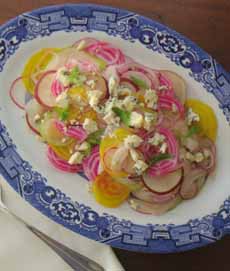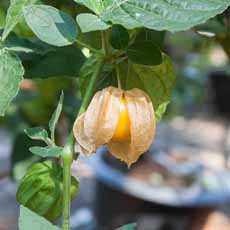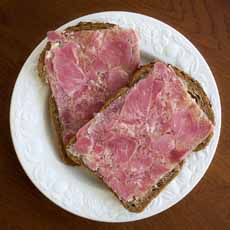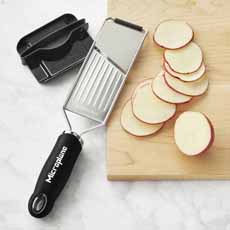TIP OF THE DAY: Shaved Salad
|
Get out your mandoline and make a shaved salad. Thinly-shaved foods not only have visual elegance, but enable a better melding of flavors on the fork. Serve them as a first course, a salad course after the main course, or a light lunch (for example, plated with cold chicken, roast, seafood). Photo #1, from Rolf & Daughters in Nashville, layers slices: ________________ *The coppa di testa or other block of charcuterie can also be sliced on the mandoline. See more about ground cherries and testa below. Photo #2 presents a shaved pear salad with beets, blue cheese and fennel. You can switch out all the elements—fruits, vegetables, dressings, etc.—to combine your favorite flavors. This recipe is from USA Pears, but during prime stone fruit season (July and August), feel free to substitute. The only caveat is that you need to slice a firm fruit. Most fruits should be used before they ripen into a softness that can’t be sliced on a mandoline. The texture to aim for is similar to an apple, pineapple or watermelon. USA Pears suggests vegetables such as cabbage, carrots, celery, sweet onion, and seasonal ingredients like delicata squash and summer squash. Ingredients For The Dressing 1. MAKE the dressing: Combine all of the ingredients in a jar with a tight-fitting lid and shake vigorously. 2. PREPARE the salad: Slice all of the vegetables as thinly as possible on a mandoline slicer, transferring them to a large bowl as you go. This can be done several hours in advance; be sure to cover the bowl tightly with plastic wrap and store in the refrigerator until ready to serve. So the pears don’t brown, just before serving the salad… 3. THINLY SLICE the pears on the mandoline, leaving the core behind. Add the pears to the bowl with the other vegetables along with about two-thirds of the dressing. Gently toss the ingredients together, sliding apart vegetables that remain stacked together with your fingers. 4. ARRANGE the salad on a platter, drizzling with more dressing, if desired. Crumble the blue cheese on top and garnish with the reserved fennel fronds. Ground cherries, Physalis pubescens, are not cherries at all. They are members of the Solanaceae family, which includes tomatoes and tomatillos as well as the cape gooseberry (their cousin), chile peppers, eggplants and potatoes. |
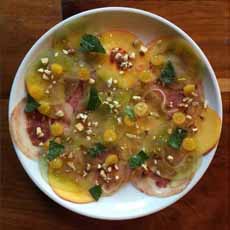 [1] A shaved salad of summer fruits on top of thinly-sliced charcuterie (photo courtesy Rolf & Daughters | Nashville).
[5] Handheld mandolines have become popular recently. They take up less room, but require more effort than the traditional models that have a fold-out stand for stability (photo courtesy Microplane). |
|
|
Like the tomatillo and cape gooseberry, ground cherries grow inside a papery husk. Other names include husk tomato, low ground-cherry and hairy ground cherry, strawberry tomato, winter cherry and a variety of others. Ground cherries are typically eaten raw, as a snack or in recipes like salads and salsas. WHAT IS HEAD CHEESE? Head cheese is a cold cut that originated in Europe. Each country has a version of it. The most popular version in the U.S. is a variation of the Italian soppressata or coppa di testa (coppa refers to air-cured pork meat). It is not a dairy cheese, but got the name because it was made in a rectangular block (terrine). The grocer sliced it the same as a loaf of cheese. The meat really does come from the head of a pig or calf (less commonly from a cow or sheep). Artisan versions are often set in aspic. Head cheese may be flavored with onion, black pepper, allspice, bay leaf, salt, and vinegar. It is usually eaten cold or at room temperature. Peasants used every part of an animal (even the “squeal,” as some oldsters like to joke). Historically, the skulls, which contain natural gelatin, were used to produce aspic. The cleaned head of the animal, all meat removed, was simmered to produce stock, a peasant food made since the Middle Ages. When cooled, the stock congeals into aspic.
|
||
